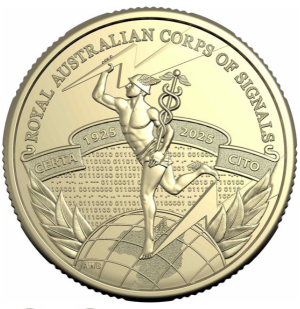Try your luck: Can you crack the secret code on this new coin?
By
Danielle F.
- Replies 0
Coins are more than change for everyday transactions; they also carry tidbits of Australia's culture and history.
In an interesting move by the Royal Australian Mint, Australia may see a new coin in rotation sometime soon.
The Mint released a new $1 coin that doubles as a puzzle waiting to be solved.
The unique $1 coin was a commemorative item just in time for the centenary of the Royal Australian Corps of Signals.
The Royal Australian Corps of Signals is a vital arm of the Australian Army, as they are responsible for managing the Army's telecommunications systems.
The Corps of Signals play a crucial role in the nation's defence as they ensure seamless communication, especially during times of conflict.
To commemorate a century of service, the Mint ingeniously incorporated two secret codes into the design of this unique coin.
The codes paid homage to the Corps' expertise in secure communication.
The new commemorative coin featured the Roman god Mercury on the head side.
Mercury is the deity of messages and communication and is located in the centre.
Also known as 'Jimmy' in the Royal Signals Cap Badge, Mercury’s toes are pointed towards Australia as a sign of the Corps' protection over the nation.
However, the real intrigue lies in the background.
The coins have a series of dashes and dots, representing a message in Morse code.
A sequence of ones and zeroes are also visible, conveying a separate message in binary.
These two codes are not just decorative elements; they testify to the Corps' evolution from traditional to contemporary forms of warfare communication.
On the flip side, the coin proudly bore the effigy of His Majesty King Charles III.
'Developing this coin was a really complex task—and there is also an interesting challenge for those who love puzzles and code-cracking,' Royal Australian Mint's acting Chief Executive Officer, Emily Martin, stated.
The story behind the coin's design was as rich as the Corps' history.
Brigadier Deane Limmer, Head of Corps for the Royal Australian Corps of Signals, shared the department's storied past with Mint artist Adam Ball.
The challenge was to encapsulate a century of progress and innovation in a single image.
The result became a coin that Brigadier Limmer saw as a fitting tribute to the dedication, innovation, and service of the men and women who have kept the Army connected and secure through a hundred years of technological transformation.
The coin may be a must-have for both coin and history lovers, but acquiring one might be a challenge.
The Mint only released 50,000 of these commemorative coins and will not enter general circulation.
However, these coins are available via the Royal Australian Mint's official shops.

So, do you fancy yourself a code-cracker? Are you intrigued by the blend of history and mystery that this new $1 coin represents? Share your thoughts in the comments section below, and let us know if you manage to decipher the hidden messages.
In an interesting move by the Royal Australian Mint, Australia may see a new coin in rotation sometime soon.
The Mint released a new $1 coin that doubles as a puzzle waiting to be solved.
The unique $1 coin was a commemorative item just in time for the centenary of the Royal Australian Corps of Signals.
The Royal Australian Corps of Signals is a vital arm of the Australian Army, as they are responsible for managing the Army's telecommunications systems.
The Corps of Signals play a crucial role in the nation's defence as they ensure seamless communication, especially during times of conflict.
To commemorate a century of service, the Mint ingeniously incorporated two secret codes into the design of this unique coin.
The codes paid homage to the Corps' expertise in secure communication.
The new commemorative coin featured the Roman god Mercury on the head side.
Mercury is the deity of messages and communication and is located in the centre.
Also known as 'Jimmy' in the Royal Signals Cap Badge, Mercury’s toes are pointed towards Australia as a sign of the Corps' protection over the nation.
However, the real intrigue lies in the background.
The coins have a series of dashes and dots, representing a message in Morse code.
A sequence of ones and zeroes are also visible, conveying a separate message in binary.
These two codes are not just decorative elements; they testify to the Corps' evolution from traditional to contemporary forms of warfare communication.
On the flip side, the coin proudly bore the effigy of His Majesty King Charles III.
'Developing this coin was a really complex task—and there is also an interesting challenge for those who love puzzles and code-cracking,' Royal Australian Mint's acting Chief Executive Officer, Emily Martin, stated.
The story behind the coin's design was as rich as the Corps' history.
Brigadier Deane Limmer, Head of Corps for the Royal Australian Corps of Signals, shared the department's storied past with Mint artist Adam Ball.
The challenge was to encapsulate a century of progress and innovation in a single image.
The result became a coin that Brigadier Limmer saw as a fitting tribute to the dedication, innovation, and service of the men and women who have kept the Army connected and secure through a hundred years of technological transformation.
The coin may be a must-have for both coin and history lovers, but acquiring one might be a challenge.
The Mint only released 50,000 of these commemorative coins and will not enter general circulation.
However, these coins are available via the Royal Australian Mint's official shops.
Key Takeaways
- The Royal Australian Mint released new $1 coins with hidden codes to commemorate the centenary of the Royal Australian Corps of Signals.
- The coin features two codes—one in Morse code and another in binary code.
- The design included an image of Mercury, the Roman god of communication, and was symbolically placed over Australia.
- The new coin will not be put into general circulation, with only 50,000 minted for collectors and enthusiasts.








